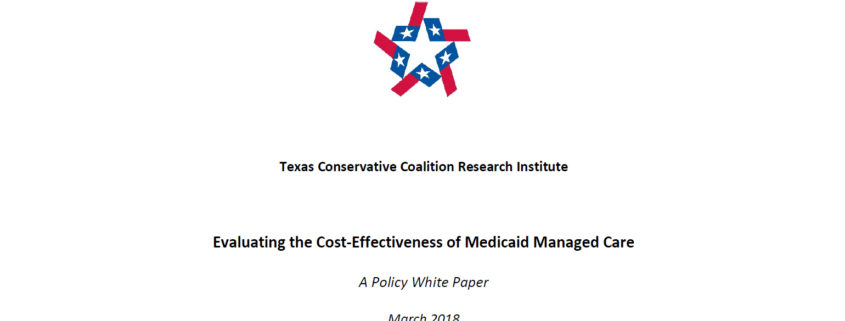Evaluating the Cost-Effectiveness of Medicaid Managed Care
Evaluating the Cost-Effectiveness of Medicaid Managed Care
The Texas Legislature first began utilizing Medicaid managed care in the early 1990s. What began as a small regional Medicaid managed care pilot in 1993 has today grown to operate in all of Texas’s 254 counties and cover over 90% of the state’s Medicaid enrollees.1 Medicaid Managed Care Organizations (MCOs) are paid billions of taxpayer dollars on an annual basis to care for some of the state’s most complex and vulnerable populations. The level of trust and responsibility placed within these plans, as well as the state’s significant investment in this model, raises the valid question of whether Medicaid managed care has continued to provide a sound return on investment, both in terms of costeffectiveness and quality of care. While this question is a very reasonable one to posit, arriving at a quantitative value by which to judge the success of Medicaid managed care is difficult, as determining a baseline for which to compare “would-be” fee-for-service (FFS) Medicaid costs and outcomes becomes problematic. Because Texas has been using the Medicaid managed care model for so long, its savings and efficiencies are assumed within the Medicaid program’s budget, thus making it problematic to determine what costs would have been under FFS.
To help analyze available data and verify the cost-effectiveness of the Texas Medicaid managed care model, the Texas Conservative Coalition Research Institute (TCCRI) procured the services of Carruth & Associates, an independent outside firm headed by the former Chief Financial Officer of HHSC. These findings are presented in their entirety in Appendix A.
While that report, and this paper, will focus primarily on cost savings associated with Medicaid managed care, this model has also shown great success in raising the quality of care for Medicaid enrollees. The Carruth & Associates report notes, “[c]ost-[e]ffectiveness is only achieved, in the long-run, through a program that delivers high quality at the lowest cost possible to maintain the value.”2 A true measure of
a system’s cost-effectiveness does not simply examine the input (i.e. state funds being put into the Medicaid program), but also the output (i.e. the quality of care and health outcomes of enrollees being served).
Key findings of the Carruth & Associates report include:
-
- When Medicaid caseloads grew by 93 percent between fiscal years (FY) 2002-2016, per member per month (PMPM) Medicaid costs increased only by a total of 17 percent, or just over one percent per year on average. This includes a significant cost increase in 2008, which was the direct result of provider rate increases due to the Frew v. Hawkins lawsuit.
- Although Texas has been steadily expanding Medicaid managed care, it was not until FY 2013, when 80 percent of Medicaid enrollees were enrolled in managed care, that just over half of all Medicaid costs were finally under the capitated model. This was achieved after additional enrollees and geographic areas, prescription drug benefits, and nursing facility care were carved into managed care. Over the past almost 15 years, MCOs have been able to successfully bend the Medicaid cost curve while only controlling a portion of the Medicaid budget. Today, about 70 percent of the total Medicaid spend is within capitation.
- Periods of significant growth in managed care tend to correspond with very low Medicaid PMPM cost growth, and in some cases, even declines:
-
-
- From FYs 2012-2016, after the state underwent a large statewide managed care expansion, overall Medicaid caseloads increased by 11 percent, while total Medicaid costs increased by 17 percent.
- However, Medicaid PMPM costs increased by less than one percent per year, while national health expenditures during this same time period experienced almost four percent per capita growth.
- Two studies using similar methods, one conducted by HHSC in 2012, and one by Milliman in 2015, arrived at comparable outcomes in validating Medicaid managed care cost savings.
- Both historical cost trend analysis and forecasted studies have demonstrated the cost-effectiveness of the Texas Medicaid managed care program.
-
Medicaid managed care has been demonstrated as one of the most effective means of bending the ever-increasing Medicaid cost curve and providing high-quality health care coverage. Health plans are able to provide better care by helping coordinate and “manage” an enrollee’s health care to more preventive, lower cost settings, and by utilizing the providers within their networks. Plans also assume financial risk should costs exceed the negotiated PMPM rate, which provides budget certainty for the state.
Since its inception as a small pilot program in the 1990’s, Medicaid managed care has grown into one of the state’s most successful initiatives, allowing Texas to utilize private sector businesses and free market innovation to better deliver government-sponsored programs. As lawmakers further explore the Medicaid managed care model in coming interim committee hearings and form recommendations for the 86th Legislative Session, it is imperative that state leaders continue to fully embrace this model and reject policies that would hinder an
MCO’s ability to continue providing higher-quality cost-effective care to the state’s Medicaid and CHIP populations.
Download full report HERE




Comments are closed.